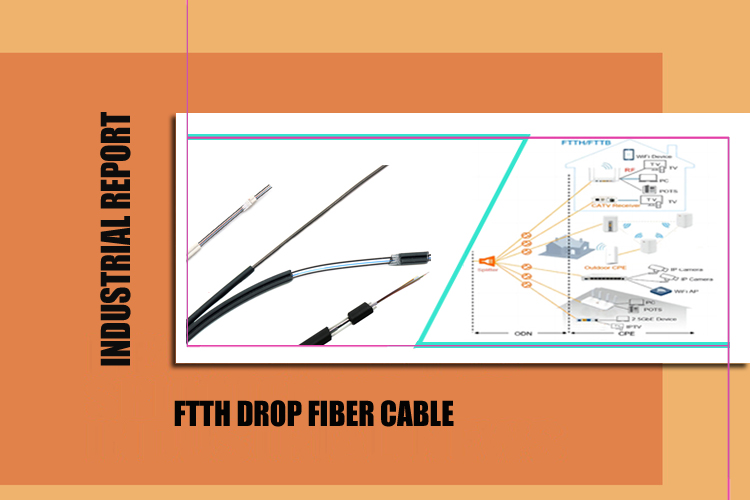The Rise of FTTH Drop Fiber Cable:
The perfect solution for low-cost high-speed communication in the last mile
The telecommunication industry is constantly evolving, with innovations and advancements in technology occurring at a rapid pace. Recently, the world has been witness to the emergence of Fiber to the Home (FTTH) drop fiber cable which signals a major leap forward in high-speed internet connectivity. The benefits of FTTH drop fiber cable are immense and extend not only to individual users but to entire communities, cities, and nations as a whole.

What is FTTH Drop Fiber Cable?
FTTH drop fiber cable is a type of fiber optic cable that connects homes and businesses directly to the internet. This cable is made up of tiny strands of glass or plastic fibers that transmit data using light signals. The cable is designed to be lightweight, flexible, and easy to install, making it an ideal solution for both urban and rural areas.
How Does FTTH Drop Fiber Cable Work?
FTTH drop fiber cable works by transmitting data through light signals. These signals are sent down the fiber strands using a laser or LED source, and they travel at incredible speeds, reaching up to 100 Gbps. The cable is connected to an optical network terminal (ONT) at the customer's premises, which converts the light signals into electrical signals that can be used by devices like computers, smartphones, and TVs.
Advantages of FTTH Drop Fiber Cable
FTTH drop fiber cable offers a number of advantages over traditional copper cables, including:
Speed: FTTH drop fiber cable offers faster internet speeds than copper cables, with speeds reaching up to 100 Gbps.
Reliability: Fiber optic cables are less susceptible to interference and signal loss than copper cables, making them more reliable and stable.
Security: Fiber optic cables are more secure than copper cables, as they are difficult to tap or intercept.
Scalability: FTTH drop fiber cable is highly scalable, meaning that it can easily be upgraded to accommodate future technologies and services.
FTTH drop fiber cable provides an advanced and cutting-edge solution for last-mile connectivity between the service provider and end-users. It enables the users to experience high-speed, secure and stable internet connections which are critical for the many functions in today’s interconnected world. Businesses can thrive on the add-on benefits of FTTH drop fiber cable which allows for seamless communication and collaboration.
One of the primary advantages of the FTTH drop fiber cable is the superior performance in terms of data transmission capabilities. Traditional copper telephone lines have limited bandwidth capacities and are unable to support high-speed data transmission. On the other hand, FTTH drop fiber cable allows for much greater bandwidth capacity. This increased bandwidth enables the delivery of a wide variety of services, including voice, video, and data, at a high quality and virtually unlimited speed.
The FTTH drop fiber cable is manufactured using innovative technology, ensuring that it is both durable and capable of withstanding harsh environmental conditions. The lightweight and flexible nature of this cable also allows for easy installation and maintenance, contributing to lower overall costs for service providers and end-users alike.
In addition to providing fast, reliable connections, FTTH drop fiber cable also offers significant energy efficiency benefits. The absence of any electrical conductivity in optical fiber eliminates the risk of electromagnetic interference and leakage, resulting in significantly reduced power consumption and a more eco-friendly solution.
Another key advantage of FTTH drop fiber cable is the reduction of latency, which is the time taken for data to travel from one point to another. The low latency offered by fiber allows for real-time communication, which is essential for various applications, including online gaming, video conferencing, and telemedicine.
The growth in demand for FTTH drop fiber cable is indicative of a shift towards smarter and more advanced living solutions. With its many benefits, it is no surprise that FTTH drop fiber cable is projected to play a major role in shaping the future of telecommunication infrastructure, leading to enhanced connectivity, convenience, and quality of life.
The future of FTTH drop fiber cable looks bright, as more and more telecom providers are adopting this technology to offer high-speed internet services to their customers. The global FTTH market is expected to grow at a CAGR of 15.2% from 2020 to 2027, driven by factors like increasing demand for high-speed internet services, rising adoption of smart homes and IoT devices, and growing government initiatives to promote digitalization.
In conclusion, FTTH drop fiber cable truly represents a game-changing technology in the telecommunication industry, paving the way for the future of high-speed internet access. As more and more communities adopt this cutting-edge technology, the world will likely experience a new times of enhanced communication and connectivity, boosting economic growth and overall quality of life.
Keywords: FTTH Drop Fiber Cable, Telecommunication Industry, High-speed Internet Connectivity, Bandwidth Capacity, Eco-friendly Solution, Low Latency

 The Future of Fiber Optic Communication Network Architecture: Evolution and the Role of SDON Technology
The Future of Fiber Optic Communication Network Architecture: Evolution and the Role of SDON Technology
 What opportunities and challenges does free-space optical communication technology face?
What opportunities and challenges does free-space optical communication technology face?
 Opelink MPO Products for High-Speed Data Center Applications
Opelink MPO Products for High-Speed Data Center Applications
 CWDM vs. DWDM: Which Optical Transmission Technology Should You Choose?
CWDM vs. DWDM: Which Optical Transmission Technology Should You Choose?